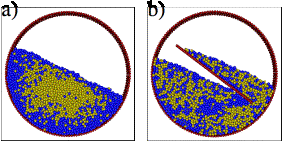

43877-AC9
Macroparticle Self-(de)Assembly: Using Janus Beads to Control Cohesive Mixing/Segregation of Fine Particles
This project is aimed, ultimately, at enhancing particle processing through control and/or minimization of de-mixing effects. This control has come in one of two forms during the project period: (1) using flow perturbations in order to minimize segregation in free-flowing systems; and (2) exploiting cohesive particle interactions in order to control mixing and segregation in fine powder systems. The work on flow perturbations explores the adaption of a widely applied fluid-processing technique to granular systems. The key idea relies on identifying two critical features of segregation: 1) that it has a preferred direction and 2) it takes a finite amount of time. In order to exploit these two observations one must perturb the flow faster than a (theoretically identified) critical frequency, essentially making segregation act as if it were "in a hamster wheel", accomplishing nothing. Interestingly, mixing – being primarily random – is not affected by these perturbations. A series of papers have been published (highlighted by a PRL contribution) on this topic, showing that the technique is viable for both tumbler mixers and chute flows and is robust to a variety of segregation mechanisms. This work has been recognized by a recent Perspectives article in Science and an similar upcoming article in Powder Technology.

Placing a single baffle near the axis of rotation of a tumbler-type mixer not only reduces the uninterrupted flow length of the free-surface material (lowering the time to segregate), but also reorients the flow prior to its next pass through the layer (changing the effective direction of segregation).
The work on cohesive segregation is progressing equally well. Two forthcoming papers will outline how systems whose interactions are dominated by van der Waals (vdW) forces may be induced to either mix or segregate by design. The crux of this work depends on the fact that the most significant cohesive interaction may be analytically determined by scaling the vdW force by the weight of the less massive particle within a particular pair. This idea has allowed us to show how to change the behavior of a system by altering the particle sizes or even by adding a third component, janus beads, that can act as "dry surfactants" or "particulate extraction agents".

Adding janus beads to a mixture of fine particulate materials can alter the behavior of the system. Depending on the relative strengths of the interactions between the various combinations of particles and, now between those particles and janus beads, can lead to a rich variety of behavior that is well-predicted by our simple scaling arguments.